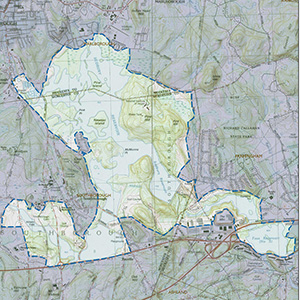Important Bird Area Sites in Massachusetts
Important Bird Area: Sudbury and Foss Reservoirs
Site Summary
Nominated By
Mark Lynch, Sheila Carroll
Size
4,500 acres
Towns and Counties
Framingham, Marlboro, Southboro; Middlesex, Worcester
Ownership
Department of Conservation and Recreation, Sudbury Valley Trustees
Major Habitats
oak-conifer forest, lake/pond, river/stream, urban/suburban, migratory stopover site
Land Use
hunting and fishing, other recreation or tourism (walking and jogging), forestry (DCR projects), water supply, suburban/residential
Site Description
This IBA is a portion of the watershed of the Sudbury and Foss Reservoirs (18,000 acres), an emergency water supply for eastern Massachusetts. The Sudbury Reservoir is fed by the Assabet River to the east. The area around the reservoir is second-growth mixed forest with stands of Red Pine. A network of trails maintained by the DCR is found on the eastern shore. The irregular shape of the reservoir includes many inlets and bays as well as several small islands, making this very attractive to migrating waterfowl. Both spring and fall, this site hosts large numbers of migratory waterfowl including significant numbers of Ring-necked and Ruddy Ducks, American Wigeons, Common Goldeneyes, Buffleheads, mergansers, and American Coots.
Current Conservation Status
Industrial development near the Foss Reservoir is extensive and care needs to be taken to prevent point pollution. Traffic along Routes 9 and the MassPike, which run adjacent to the reservoirs, may provide other sources of pollution. Human disturbance is growing, as the area becomes better known to hikers, joggers, and fishermen.
Ornithological Significance
Other waterfowl species not listed below that regularly migrate through this area include: Pied-billed Grebe, Double-crested Cormorant (generally fewer than 20), Canada Goose (counts of 160 to 290), Mallard (counts of 50), American Black Duck (generally fewer than 10 per day), Green-winged Teal (small numbers), Hooded Merganser (typically 20 to 50 per daily count), American Coot (daily counts in fall range from 2 to 12). Waterfowl species not typically found in central Massachusetts that have appeared in just the last few years include: Canvasback, Redhead, and Eurasian Wigeon.
Besides the concentration of waterfowl, there is the Great Blue Heron rookery (four nests and increasing) on an island in the southern section of the Sudbury Reservoir. Migrant land birds find the area very attractive, especially the eastern shore. Several species that linger into winter are very uncommon in that season in Worcester County: Gray Catbird, Hermit Thrush, and Yellow-rumped Warbler.
Other Flora or Fauna of Significance
None listed.
Data Sources
Systematic point counts are of the Sudbury Reservoir section only and were conducted by the authors for the past 10 or so years. The counts above represent typical single-day counts at Sudbury Reservoir where the authors run a standardized point count predominantly in the fall. Counts of Foss Reservoir are difficult to do because of geography (bordered by private corporate land, Mass Pike, and Route 9). NB: waterfowl of all species mentioned appear both spring and fall in both bodies, but generally the highest counts of most species are in the fall.




